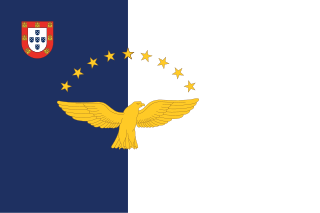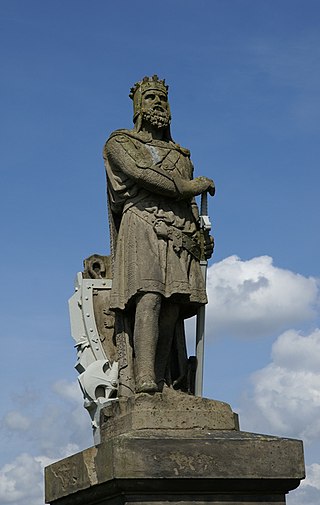Examples
- Atlas
- Bunsen
- Gassendi
- Humboldt
- Komarov
- Kostinskiy
- Lavoisier
- Olbers
- Tamm (top) and van den Bos (bottom)
- Ritter
- Vitello
- Warner
- Zwicky N
This is a list of craters indicated as having a fractured crater floor in Plate 5A. Structural Features of The Geologic History of the Moon [1] by Don Wilhelms.

The Azores, officially the Autonomous Region of the Azores, is one of the two autonomous regions of Portugal. It is an archipelago composed of nine volcanic islands in the Macaronesia region of the North Atlantic Ocean, about 1,400 km (870 mi) west of Lisbon, about 1,500 km (930 mi) northwest of Morocco, about 1,930 km (1,200 mi) southeast of Newfoundland, Canada, and the same distance southwest of Cork, Ireland.

The Cambrian is the first geological period of the Paleozoic Era, and the Phanerozoic Eon. The Cambrian lasted 51.95 million years from the end of the preceding Ediacaran period 538.8 Ma to the beginning of the Ordovician Period 486.85 Ma.

Cairo is the capital and largest city of Egypt and the Cairo Governorate, being home to more than 10 million people. It is also part of the largest urban agglomeration in Africa, the Arab world and the Middle East. The Greater Cairo metropolitan area is the 12th-largest in the world by population with over 22.1 million people.

Anatomically modern humans first arrived on the Indian subcontinent between 73,000 and 55,000 years ago. The earliest known human remains in South Asia date to 30,000 years ago. Sedentariness began in South Asia around 7000 BCE; by 4500 BCE, settled life had spread, and gradually evolved into the Indus Valley Civilisation, one of three early cradles of civilisation in the Old World, which flourished between 2500 BCE and 1900 BCE in present-day Pakistan and north-western India. Early in the second millennium BCE, persistent drought caused the population of the Indus Valley to scatter from large urban centres to villages. Indo-Aryan tribes moved into the Punjab from Central Asia in several waves of migration. The Vedic Period of the Vedic people in northern India was marked by the composition of their extensive collections of hymns (Vedas). The social structure was loosely stratified via the varna system, incorporated into the highly evolved present-day Jāti system. The pastoral and nomadic Indo-Aryans spread from the Punjab into the Gangetic plain. Around 600 BCE, a new, interregional culture arose; then, small chieftaincies (janapadas) were consolidated into larger states (mahajanapadas). Second urbanization took place, which came with the rise of new ascetic movements and religious concepts, including the rise of Jainism and Buddhism. The latter was synthesized with the preexisting religious cultures of the subcontinent, giving rise to Hinduism.

The reindeer or caribou is a species of deer with circumpolar distribution, native to Arctic, subarctic, tundra, boreal, and mountainous regions of Northern Europe, Siberia, and North America. It is the only representative of the genus Rangifer. More recent studies suggest the splitting of reindeer and caribou into six distinct species over their range.

Conquistadors or conquistadores is the term used to refer to Spanish and Portuguese soldiers and explorers who carried out the conquests and explorations of the Age of Discovery. Conquistadors sailed beyond the Iberian Peninsula to the Americas, Oceania, Africa and Asia, establishing new colonies and trade routes. They brought much of the "New World" under the dominion of Spain and Portugal.

The name Robert is an ancient Germanic given name, from Proto-Germanic *Hrōþi- "fame" and *berhta- "bright" (Hrōþiberhtaz). Compare Old Dutch Robrecht and Old High German Hrodebert. It is the second most frequently used given name of ancient Germanic origin. It is also in use as a surname. Another commonly used form of the name is Rupert.

Football hooliganism, also known as soccer hooliganism, football rioting or soccer rioting, constitutes violence and other destructive behaviors perpetrated by spectators at association football events. Football hooliganism typically involves conflict between pseudo-tribes, formed to intimidate and attack supporters of other teams. Certain clubs have long-standing rivalries with other clubs and hooliganism associated with matches between them can be more severe. An example of this is the Devon Derby . Conflict may arise at any point, before, during or after matches and occasionally outside of game situations. Participants often select locations away from stadiums to avoid arrest by the police, but conflict can also erupt spontaneously inside the stadium or in the surrounding streets. In extreme cases, hooligans, police and bystanders have been killed, and riot police have intervened. Hooligan-led violence has been called "aggro" and "bovver".

The Yellowstone hotspot is a volcanic hotspot in the United States responsible for large scale volcanism in Idaho, Montana, Nevada, Oregon, and Wyoming, formed as the North American tectonic plate moved over it. It formed the eastern Snake River Plain through a succession of caldera-forming eruptions. The resulting calderas include the Island Park Caldera, Henry's Fork Caldera, and the Bruneau-Jarbidge caldera. The hotspot currently lies under the Yellowstone Caldera. The hotspot's most recent caldera-forming supereruption, known as the Lava Creek Eruption, took place 640,000 years ago and created the Lava Creek Tuff, and the most recent Yellowstone Caldera. The Yellowstone hotspot is one of a few volcanic hotspots underlying the North American tectonic plate; another example is the Anahim hotspot.

Maps have been one of the most important human inventions for millennia, allowing humans to explain and navigate their way through the world.

Franklin's lost expedition was a failed British voyage of Arctic exploration led by Captain Sir John Franklin that departed England in 1845 aboard two ships, HMS Erebus and HMS Terror, and was assigned to traverse the last unnavigated sections of the Northwest Passage in the Canadian Arctic and to record magnetic data to help determine whether a better understanding could aid navigation. The expedition met with disaster after both ships and their crews, a total of 129 officers and men, became icebound in Victoria Strait near King William Island in what is today the Canadian territory of Nunavut. After being icebound for more than a year, Erebus and Terror were abandoned in April 1848, by which point two dozen men, including Franklin, had died. The survivors, now led by Franklin's second-in-command, Francis Crozier, and Erebus's captain, James Fitzjames, set out for the Canadian mainland and disappeared, presumably having perished.
The captain of a steam ship naturally chooses the shortest route to nearby destinations. Since a sailing ship is usually pushed by winds and currents, its captain must find a route where the wind will probably blow in the right direction. Tacking, i.e. using contrary wind to pull (sic) the sails, was always possible but wasted time because of the zigzagging required, and significantly delayed long voyages. The early European explorers were not only looking for new lands. They also had to discover the pattern of winds and currents that would carry them where they wanted to go. During the Age of Sail, winds and currents determined trade routes and therefore influenced European imperialism and modern political geography. For an outline to the main wind systems see Global wind patterns.
Early Polynesian explorers reached nearly all Pacific islands by 1200 CE, followed by Asian navigation in Southeast Asia and the West Pacific. During the Middle Ages, Muslim traders linked the Middle East and East Africa to the Asian Pacific coasts, reaching southern China and much of the Malay Archipelago. Direct European contact with the Pacific began in 1512, with the Portuguese encountering its western edges, soon followed by the Spanish arriving from the American coast.